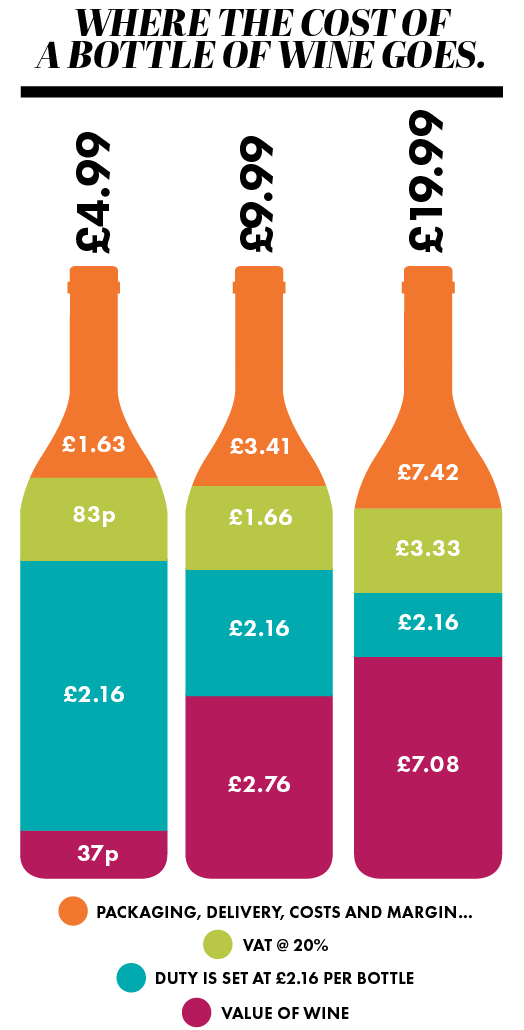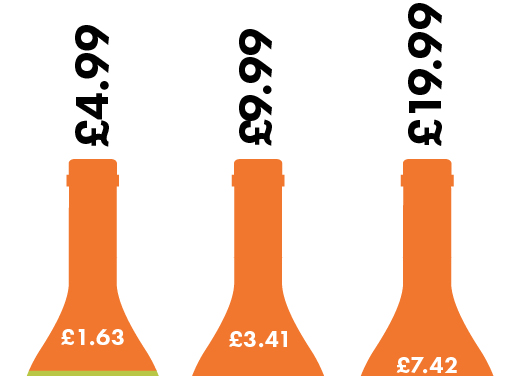Thirsty’s Elodie Cameron considers the sweet spot between price and quality
We have all stood in front of a shelf full of wine weighing up whether or not to spend a bit more. Invariably when you look at the price of a bottle of wine you are making a judgment on the contents of the bottle, the value of the wine you are about to purchase and, in turn, drink. Clearly the price tag includes much more that just the wine you are drinking, but do you know just how much goes into tax, shipping, the cost of the bottle and label – not to mention the marketing and advertising that the big brands spend?
Of course, the idea that the more you spend, the better the wine you drink may seem obvious – but how much better are we talking? If you spend twice as much what happens to the quality of wine in your bottle? You may be amazed to realise that if you increase your spend on a bottle of wine from £4.99 to £9.99 the value of the wine might not double, but increase seven times over! Amazed? I thought as much.
Perhaps you are wondering how that can be. Well, many of the costs involved in getting a bottle of wine from the vineyard to your table stay the same as the price increases. Alcohol duty is now £2.16 on every bottle: a significant proportion of a budget of £4.99, and of course we all know that VAT is 20{b486c5a37ab2d325d17e17d701cb2567b1ecd1814e8ceb33effa2a4f1f171d46}, so tax alone has already accounted for almost 60{b486c5a37ab2d325d17e17d701cb2567b1ecd1814e8ceb33effa2a4f1f171d46} of your spend. Then, of course the retailer needs to add a margin as does the importer (nothing crazy – about a pound or so between them). We must not forget the shipping and of course, the wine needs to go in a bottle with a label, closure (be it cork or screw cap) and popped into a box. And before you know it the wine inside is only worth 38p. Oh, and we haven’t even thought about all the advertising, marketing and promotion for those big supermarket brands.
Now, if you compare this to your bottle at £9.99, duty is the same; VAT is still 20{b486c5a37ab2d325d17e17d701cb2567b1ecd1814e8ceb33effa2a4f1f171d46}, albeit of a greater value; the shipping, bottling and all the other bits and bobs are pretty consistent – about 60p depending where your wine is coming from. This allows the importer and retailer to rake in a whopping £3 or so – and most importantly for you the wine inside the bottle is worth around £2.76: around seven times more.
It seems a no-brainer in this era of considered drinking, and the health implications that we are constantly reminded of, that if you spend the same, yet drink a little less, your pleasure will be multiplied – now that really sounds interesting. So the moral of this story is that around £10 is a sweet spot for wine where you can achieve both good quality and a good price. This is definitely a moment where quality over quantity reigns.
Another thought springs to mind on this issue too. If we go back to the brands sold in supermarkets, they are spending significant money on advertising, marketing and promotions, which we have not included in our costs. Perhaps the wise move is to up the spend a little, go to an independent merchant for quality wines and informed advice on wines from winemakers who put 100{b486c5a37ab2d325d17e17d701cb2567b1ecd1814e8ceb33effa2a4f1f171d46} of their efforts into what’s in the bottle.
Food for thought, or perhaps we should say wine for thought.


